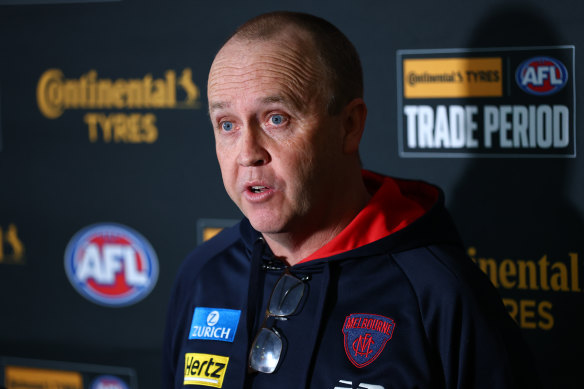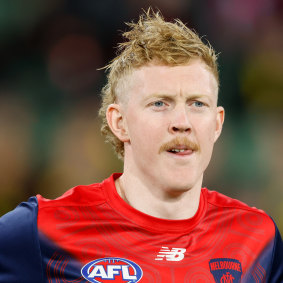This was published 4 months ago
Opinion
Melbourne’s poor handling of Oliver has turned the trade window into a peep show
Greg Baum
Sports columnistIt’s called a trade window, but it’s not really a window. It’s an opening with a blind pulled down over it, beneath which everyone inside keeps peeping out, and everyone outside keeps watching out for shadows. And so we end up with the Clayton Oliver debacle.
Unarguably, Melbourne’s leaders have handled the whole episode poorly, and it is not over yet. Nor has Oliver covered himself in glory. All of which left list manager Tim Lamb in an impossible position when he faced media on Monday. But the underlying problem is the system, itself.

Tim Lamb faced some difficult questions about Clayton Oliver on Monday.Credit: AFL Photos
The AFL apparatus severely restricts the way players move between clubs. Mostly this is a good thing, helping to maintain an even and vibrant competition. But it also dictates when a player can move, limiting it to two short post-season windows. When those windows open, no matter how opaque, the spectacle sometimes tends to be ghoulish.
For the rest of the time, club and player are obliged to feign undying love, even when disaffected. Loyalty is exalted as a footy virtue, but club and player loyalty can never be like a fan’s loyalty; it can only ever be for as long as they are useful to each other, and sometimes tolerate one another. There appears to be an element of this at work at Melbourne.
Some AFL clubs and managers are not up to managing the nuances needed to work within the protocols and conventions of the AFL system. What ensues is a series of awkward interviews, speeches and releases in which everyone hedges, obfuscates, hesitates and – let’s face it – sometimes downright lies. In their efforts to tip-toe around the truth, some end up flat on their faces.

Clayton Oliver.Credit: AFL Photos
But the players don’t protest it because the system is working, or could one day work in their favour. Ditto the clubs. Managers don’t protest because it is already working in their favour. Only the fans lose out.
The contrast is with the NRL, where it is common for a player to announce in the middle of one season that he will be playing for another club the next, without prejudice to his selection for the balance of that season, nor generally a lessening of his favour with fans.
It works well enough in the NRL partly because the player movement rules are looser anyway, and loyalty generally is looser; fans regularly change teams like players do.
Loyalty is exalted as a footy virtue, but club and player loyalty can never be like a fan’s loyalty; it can only ever be for as long as they are useful to each other.
Would it work in AFL? Professional pride would guarantee that a player would give his all in the remaining time, especially to a club in contention, and it’s unlikely that a coach would stand him down.
Firstly, it would be cutting off the coach’s nose to spite his face. Secondly, it would be hypocritical; the coach also is a contracted employee, and very probably was once contracted to another club and in the future will be contracted to a different club again.
Transparency would not be a cure-all. In Oliver’s case, the scale of his contract complicates all considerations. It means that in a speculated move to Geelong, he would likely lose money, Melbourne face and Geelong draft capital or salary cap room. There aren’t many winners in that scenario.
Meantime, the AFL version of buy, swap and sell plays out in full public view behind closed doors. The AFL’s attitude to the NRL way has always been that it wouldn’t be a good look. But how good does the AFL way look right now?
Get daily updates on all the AFL trade period action. Sign up for our Real Footy newsletter.